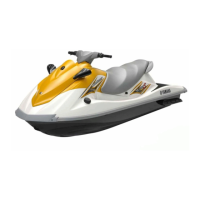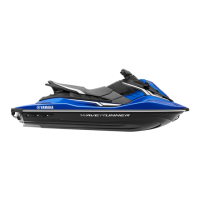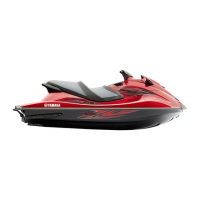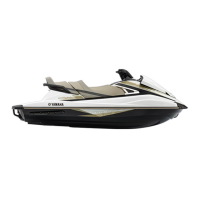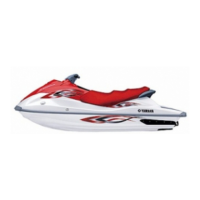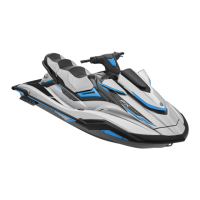Do you have a question about the Yamaha WaveRunner V1 2016 and is the answer not in the manual?
Explains how to find and record PRI-ID, HIN, and engine serial numbers.
Details engine emission standards and certification compliance.
Explains the manufactured date label and CARB star ratings for emissions.
Provides an overview of essential and warning labels found on the watercraft.
Describes various other labels, including capacity and certification.
Covers age, supervision, load limits, and passenger experience for safe operation.
Advises on defensive driving, speed, distance, and visibility.
Details essential safety gear like PFDs, protective clothing, and helmets.
Warns about exhaust fumes, hot parts, and explains jet thrust steering.
Guidelines for safely towing wakeboarders or water-skiers.
Explains navigation rules, right-of-way, and vessel interactions.
Lists organizations and resources for additional boating safety information.
Emphasizes respecting others, nature, and proper maintenance.
Defines key terms related to watercraft operation and components.
Identifies and illustrates exterior components of the watercraft.
Explains the display and operation of the main information center.
Details reading the speedometer and tachometer, and changing units.
Describes hour meter, voltmeter, fuel level meter, and warning indicators.
Instructions for seat removal/installation and handgrip usage.
Details the reboarding step and uses of bow/stern eyes and cleats.
Information on storage, glove compartment, and fire extinguisher holder.
Specifies recommended fuels, octane, oil types, grades, and capacities.
Instructions for draining bilge water and transporting on a trailer.
Essential steps for breaking in the engine for optimal performance and longevity.
A summary table of all pre-operation checks required before use.
Detailed checks to perform before launching the watercraft.
Checks to perform after launching and starting the engine.
Covers familiarization, practice, controls, and basic riding.
Details riding positions, launching, and starting the engine on water.
Covers stopping the engine, leaving the craft, basic V1/V1 Sport operation, and turning.
Explains reverse use, capsizing, beaching, docking, weeded areas, and starting off.
Step-by-step instructions for boarding alone and with passengers.
Procedures for discharging water from cooling passages after use.
General care after use and steps to flush cooling passages.
Instructions for cleaning the watercraft and maintaining the battery.
Procedures for preparing for storage and lubricating moving parts.
Steps for rustproofing various parts of the watercraft.
A schedule for routine maintenance checks and services.
Lists the tools included with the watercraft for maintenance.
Recommends dealer service or DIY guidance for oil and filter changes.
Lists capacity, dimensions, and weight specifications.
Outlines engine type, displacement, and performance data.
Details recommended fuel, oil, and fluid capacities.
A chart to diagnose and resolve common watercraft problems.
Steps for cleaning the jet intake, jump-starting, and towing.
Procedures for handling a submerged watercraft, including draining and service.
Outlines the terms, conditions, and exclusions of the Yamaha limited warranty.
Addresses common warranty questions and how to get service.
Details the benefits and options of Yamaha's extended service plan.
Explains how to find and record PRI-ID, HIN, and engine serial numbers.
Details engine emission standards and certification compliance.
Explains the manufactured date label and CARB star ratings for emissions.
Provides an overview of essential and warning labels found on the watercraft.
Describes various other labels, including capacity and certification.
Covers age, supervision, load limits, and passenger experience for safe operation.
Advises on defensive driving, speed, distance, and visibility.
Details essential safety gear like PFDs, protective clothing, and helmets.
Warns about exhaust fumes, hot parts, and explains jet thrust steering.
Guidelines for safely towing wakeboarders or water-skiers.
Explains navigation rules, right-of-way, and vessel interactions.
Lists organizations and resources for additional boating safety information.
Emphasizes respecting others, nature, and proper maintenance.
Defines key terms related to watercraft operation and components.
Identifies and illustrates exterior components of the watercraft.
Explains the display and operation of the main information center.
Details reading the speedometer and tachometer, and changing units.
Describes hour meter, voltmeter, fuel level meter, and warning indicators.
Instructions for seat removal/installation and handgrip usage.
Details the reboarding step and uses of bow/stern eyes and cleats.
Information on storage, glove compartment, and fire extinguisher holder.
Specifies recommended fuels, octane, oil types, grades, and capacities.
Instructions for draining bilge water and transporting on a trailer.
Essential steps for breaking in the engine for optimal performance and longevity.
A summary table of all pre-operation checks required before use.
Detailed checks to perform before launching the watercraft.
Checks to perform after launching and starting the engine.
Covers familiarization, practice, controls, and basic riding.
Details riding positions, launching, and starting the engine on water.
Covers stopping the engine, leaving the craft, basic V1/V1 Sport operation, and turning.
Explains reverse use, capsizing, beaching, docking, weeded areas, and starting off.
Step-by-step instructions for boarding alone and with passengers.
Procedures for discharging water from cooling passages after use.
General care after use and steps to flush cooling passages.
Instructions for cleaning the watercraft and maintaining the battery.
Procedures for preparing for storage and lubricating moving parts.
Steps for rustproofing various parts of the watercraft.
A schedule for routine maintenance checks and services.
Lists the tools included with the watercraft for maintenance.
Recommends dealer service or DIY guidance for oil and filter changes.
Lists capacity, dimensions, and weight specifications.
Outlines engine type, displacement, and performance data.
Details recommended fuel, oil, and fluid capacities.
A chart to diagnose and resolve common watercraft problems.
Steps for cleaning the jet intake, jump-starting, and towing.
Procedures for handling a submerged watercraft, including draining and service.
Outlines the terms, conditions, and exclusions of the Yamaha limited warranty.
Addresses common warranty questions and how to get service.
Details the benefits and options of Yamaha's extended service plan.



